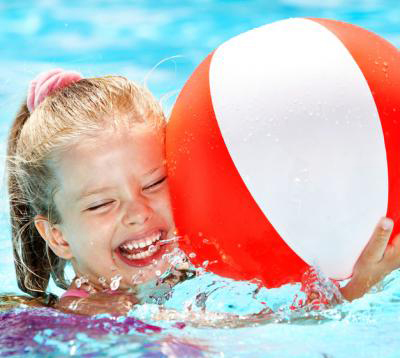Information you need to live a happy, worry-free retirement!
- Home
- » Resources
- » Blog
- » Wellness
- » Water and Sun Safety
Originally published July 8, 2013, last updated February 20, 2014
Water and Sun Safety

Pool Time Preparations
It’s a moment that still terrorizes me. The sight of the drain at the bottom of the swimming pool, getting closer as though floating up toward me, then total darkness…
Next thing I knew, I was looking up at the lights from the YMCA ceiling and the face of a lifeguard. “Can you hear me?” he asked. Slowly, I swam back to consciousness – but to this day, over 35 years later, I still cannot swim. I’m too afraid to learn.
Even in a protected environment, pool safety is anything but guaranteed. In my case, my fourth-grade friends were simply roughhousing with me. I was in the shallow end, but they pulled me over to deeper waters. Still, I was having fun…until they dunked my head beneath the water and shoved me downward.
Despite that memory, today I enjoy treading along the shallow side of the pool but, understandably, am very safety conscious. And while you may not have a traumatic experience serving as motivation, safety should be foremost for you, too – especially when involving children. The average child stays on the surface of the water for only 10 seconds and the drowning process can start after they are submerged within 20 seconds.
As you plan your pool fun, start with these five vital precautions in mind:
- Learn CPR and insist that baby-sitters, grandparents and others who care for your child know CPR. Post CPR instructions in the pool area.
- Caution children against showing off and playing rough and explain the dangers of running and diving recklessly. Never push others into the pool.
- Teach children and inexperienced or non-swimmers to stay in the shallow end.
- Always swim with a buddy; never swim alone, even in your own pool.
- Don’t swim if you’re under the influence of alcohol or other drugs.
Pool readiness
Your pool should be completely enclosed with a self-locking, self-closing fence with vertical bars. Openings in the fence should be no more than four inches wide. The house should not be included as a part of the barrier. Make sure your pool deck is made of or treated with slip-resistant materials, and pool covers should always be completely removed prior to pool use.
The steps of the pool ladder should be at least three inches wide, and the ladder should have handrails on both sides small enough for a child to grasp. There should be a ladder at both ends of the pool. Check with a professional pool contractor to be sure the depth is sufficient for a diving board or slide. Always put a slide in a deep area of the pool – never in shallow water.
If you have an above-ground pool, install sturdy guard rails around the pool deck. Look for rolled rims on the metal shell to be sure the rims do not present a sharp cutting edge if someone falls. The access ladder to the deck should be sturdy and without protruding bolts or other sharp edges, and should either swing up to prevent children from unauthorized entry or easily removable for secure storage away from the pool area.
Swim day checklist
Next, before anyone heads to the pool, review this checklist to ensure you’re fully safe for swimming:
- Remove electrical appliances such as radios from the pool area because of the hazard of electrical shock.
- Make sure the depths of your pool are clearly marked.
- Always keep basic lifesaving equipment by the pool and know how to use it. Pole, rope, and personal flotation devices are recommended.
- Remove furniture that would enable a child to climb over the fence or fall.
Of course, pool time and sun safety go hand-in-hand. Toronto Public Health offers these six pointers to keep in mind to protect you from sunburn and possible skin cancer.
- Limit time in the sun during afternoon hours. When possible, plan outdoor activities to avoid being outside when the sun’s rays are the strongest.
- Do outdoor activities in shady spots (e.g. under a tree or in the shade of a building). Create shade by using an umbrella, awning, gazebo or canopy.
- Wear a hat with a wide brim or with a back flap. This will help shade the head, face, eyes, ears and neck areas. Hats made of tightly woven fabric are best.
- Wear clothing to protect as much skin as possible. Long-sleeved shirts and long pants (or at least knee-length shorts) are recommended even on cloudy days. Fabrics that block out the light when held up to a light bulb will help to block UV rays better. T-shirts (in addition to sunscreen) can be worn when in the water.
- Wear UVA and UVB protective sunglasses that wrap around the face.
- Use a sunscreen with SPF 15 or higher that gives protection from both UVA and UVB rays. Sunscreen should be applied about 30 minutes before sun exposure. Apply a second time 20 minutes later, and reapply every two hours or after swimming, toweling off or exercising. “Sunburn tends to sneak up on us,” said Barton Schmitt, a pediatrician at Children’s Hospital Colorado. “It can take four to six hours for the symptoms to develop.” Sunscreen should be used even on cloudy, hazy or foggy days.
Do all you can to be pool time prepared – and your fun will be terrific, not terrorizing.
Adam Colwell is president of his own writing and editing production company. He is married, father of two daughters and lives in Tucson, AZ.



